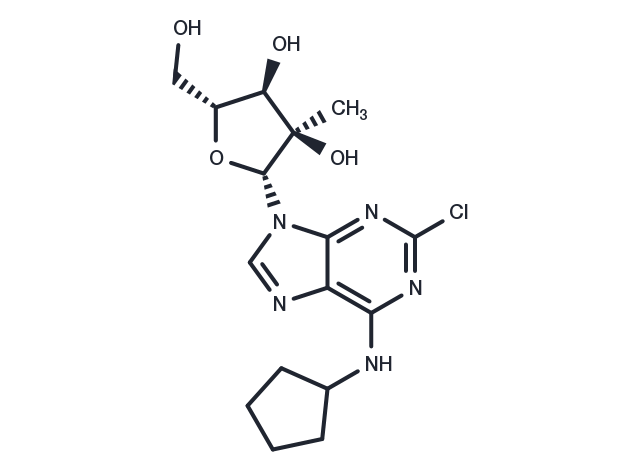Powder: -20°C for 3 years | In solvent: -80°C for 1 year


2'-MeCCPA is a potent and highly selective A1 adenosine receptor (A1AR) agonist with a K-value of 1.8 nM for AR.2'-MeCCPA inhibits trichostatin-stimulated adenylate cyclase activity with an IC value of 13.1 nM.2'-MeCCPA exhibits analgesic activity and can be used in the study of HCV.

| Pack Size | Availability | Price/USD | Quantity |
|---|---|---|---|
| 1 mg | In stock | $ 83.00 | |
| 5 mg | In stock | $ 198.00 | |
| 10 mg | In stock | $ 328.00 | |
| 25 mg | In stock | $ 552.00 | |
| 50 mg | In stock | $ 787.00 | |
| 100 mg | In stock | $ 1,070.00 | |
| 500 mg | In stock | $ 2,130.00 |

| Description | 2'-MeCCPA is a potent and highly selective A1 adenosine receptor (A1AR) agonist with a K-value of 1.8 nM for AR.2'-MeCCPA inhibits trichostatin-stimulated adenylate cyclase activity with an IC value of 13.1 nM.2'-MeCCPA exhibits analgesic activity and can be used in the study of HCV. |
| In vivo | During reperfusion, 2'-MeCCPA (1 nM-1 M) significantly reduces the infarct area and risk ratio in male Sprague-Dawley rats[2]. |
| Synonyms | 2-Chloro-N-cyclopentyl-2′-C-methyladenosine |
| Molecular Weight | 383.83 |
| Formula | C16H22ClN5O4 |
| CAS No. | 205171-12-6 |
Powder: -20°C for 3 years | In solvent: -80°C for 1 year
DMSO: 100 mg/mL (260.53 mM), Sonication is recommended.
You can also refer to dose conversion for different animals. More
bottom
Please see Inhibitor Handling Instructions for more frequently ask questions. Topics include: how to prepare stock solutions, how to store products, and cautions on cell-based assays & animal experiments, etc.
2'-MeCCPA 205171-12-6 GPCR/G Protein Microbiology/Virology Neuroscience Proteases/Proteasome HCV Protease Adenosine Receptor 2-Chloro-N-cyclopentyl-2′-C-methyladenosine 2'MeCCPA 2' MeCCPA inhibitor inhibit
